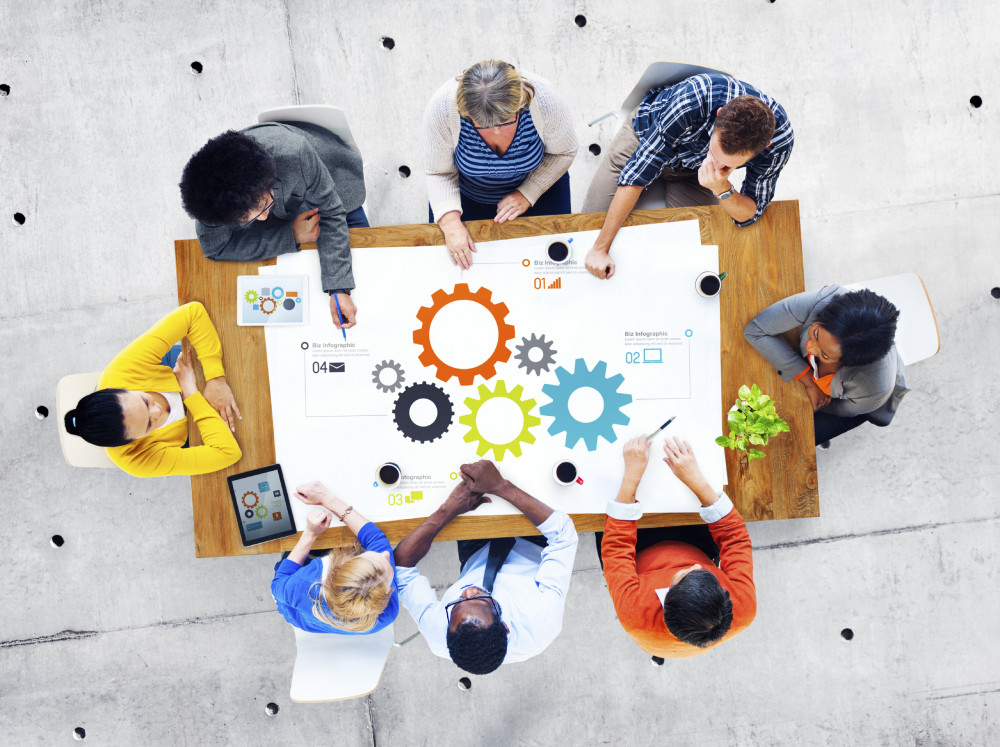While there are many aspects of my detail to The Innovation Lab at the Office of Personnel Management that I enjoy, one of my favorites is access to the Lab’s space in the sub-basement of OPM’s Theodore Roosevelt Federal Building. The space is a dream for those seeking a creative and collaborative work environment. For starters, it looks nothing like the normal government office space.
The walls are covered in blackboard paint, whiteboard paint or cork board, and additional moveable white boards can be found throughout the space. The main area is large and open, divided into different parts by the placement of furniture. For example, in the middle of the room, there are moveable tables set up into multiple working spaces, while the back is broken up into a number of smaller working areas through the placement of couches and chairs. Interested in some privacy? Off of the main area are two smaller working rooms.
Not only is the Lab a space that encourages a collaborative approach through its physical design, it also contains tools that help to facilitate creative interactions and spur new ideas, like sticky notes, Legos, and play dough, among many others. I know that when I return to my regular job at the end of next month, I am going to miss access to such a dynamic space.
Like many other government employees, my daily work setting is a cubicle farm. Because of this, the most common place for groups to gather is in conference rooms. While our building contains a number of conference rooms, reserving them is difficult. They are often booked out many months in advance, and they are extremely difficult to acquire on short notice. Even if you are able to reserve a conference room, no real flexibility exists in terms of changing the set-up of the room, and more often than not, supplies that could help make a meeting more interactive are not available.
Just because your office building does not contain a creative co-working space does not mean that you cannot be inspired to work differently within the pre-existing confines of your office environment. Here are three ways that you can build your own creative space at work.
- Repurpose unused cubicles or offices.
When the fight for conference rooms gets real, pull your team into a vacant cubicle or office. Use the constraints of the size of the space as a prompt to work differently during your meeting. Say you’re working in an unused cubicle, but there’s not enough space for seating. Call it a “huddle meeting” where you have to stand the entire time. Just imagine what different results that meeting might have from change in perspective (from seated to standing). If nothing else, it may encourage you all to get to consensus sooner!
- Share supplies.
Depending on your team or office’s budget, supplies may be hard to come by. I know that some teams in my office have more flexibility purchasing certain types of supplies than others, due to the nature of their work. At the end of the year, I often have more post-its and sharpies than I had time to use. I’d be happy to share some of my supplies with other teams, if I could have periodic access to their poster board and white board markers. Talk to some of your colleagues and see how you can leverage one another’s resources to create a more holistic pool of supplies. Once you do, make sure to think of ways to incorporate these tools into your meetings to make them more interactive.
- Get out of the office.
A change in scenery can really make all the difference. Is your office close to a Starbucks, food court, or park? If so, take advantage of that and ask your team to join you in a different environment. Use the new setting to influence the agenda of your meeting and manage the meeting in new ways. Maybe this manifests itself as an opportunity to get quick, real-time feedback on an idea that you flushed out over the course of the meeting by asking a few people in Starbucks. If nothing else, often switching up your routine can result in new ideas.
In the comments, I’d love to hear other ideas for how we can build creative spaces, both physically and mentally, in our work environments.
Blair Corcoran de Castillo is part of the GovLoop Featured Blogger program, where we feature blog posts by government voices from all across the country (and world!). To see more Featured Blogger posts, click here.





Fascinating!
Great post Blair! I definitely think open spaces are the new trend and lead to a more innovative and collaborative work environment. Our group recently performed a coloring exercise and it was such a great way to unleash some creative brain power, plus we got to hang up our drawings afterwards. Fun way to get innovative and decorate!
Hi Francesca – thanks for your comments! I love the idea of the coloring exercise!
Awesome job!
Great post, Blair! you really encapsulated this idea of low tech supplies for a collaborative work environment.
Thanks, Elaine!!
#3 – one of my favorite addition – “do a walk and talk” outside meeting
Hi Steve – I love the idea of a walking meeting!
I am most creative when I’m teleworking. I’m able to listen to inspiring music, rub my dog’s belly for stress relief, stand up while working, and have all my devices humming in harmony! My ideal work station!